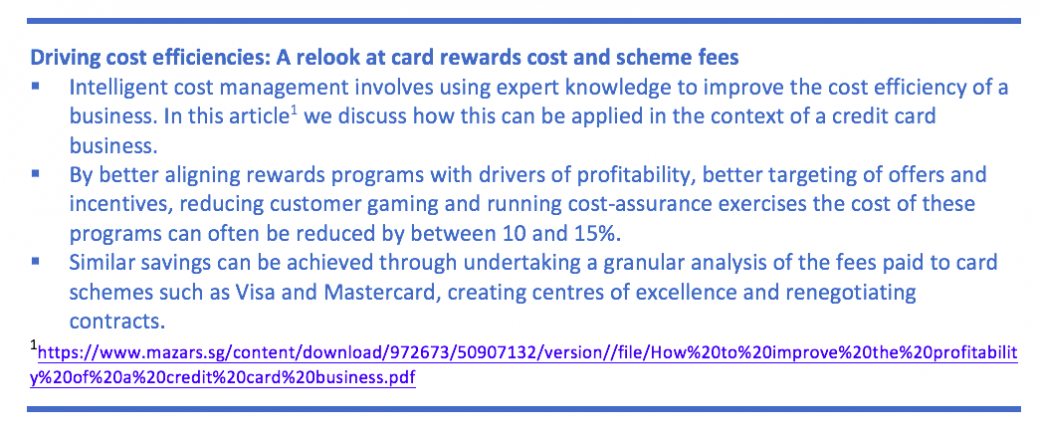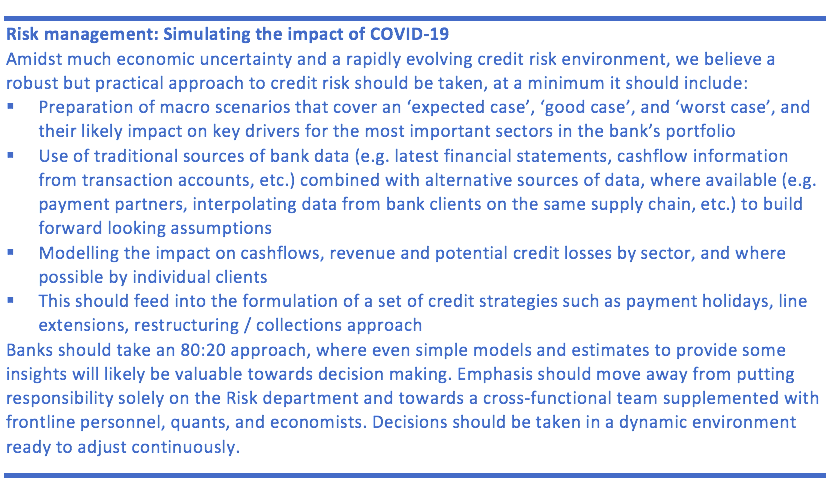How banks can prepare for life after containment
How banks can prepare for life after containment
We see this next phase as a transitionary phase lasting six to twelve months in an environment that will gradually return to a ‘new normal’. There will likely be some permanent changes to working practices, the way customers bank, and shifting stakeholder expectations. In this transitionary phase, banks are likely to face a situation still in flux with economic uncertainly and evolving customer demands. At the same time, they will need to assess and plan for structural changes in response to the ‘new norm’.
Taking action to assume competitive advantage
- Ensure a safe physical environment
- As containment measures ease and customers start to return to the branch, physical hygiene and safety will remain the immediate concern for customers and staff. It is imperative that the branch provides a safe environment, for example with a redesigned layout to facilitate social distancing, self-sanitising coatings on contact points, mask-wearing protocols and visible use of hand sanitisers.
- Such measures need to be implemented sensitively without causing undue worry. We believe some real effort towards designing this bespoke, rather than just a ‘tick-the-box’ compliance exercise, will make a real difference to the customer.
- Accelerate the digital offer
- With empirical proof that high levels of digital banking and interaction are possible, financial institutions should double down on efforts towards digital transformation and build on the learnings from this period of forced experimentation.
- Banks should also continue to assist customers towards adoption of digital banking, especially as they start to come back to the branch for both individual and businesses related services. This is especially important for less tech-savvy segments, which are now more likely to accelerate their own adoption.
- Engage the customer
- A crisis is the optimal time to proactively engage with the customer (both individual and corporate) on a holistic basis. It represents a key “moment of truth” which if handled well can enforce strong relationships for years to come.
- Rethinking savings and protection plans will be top of mind for many. For the affluent customer, reassessing their investment portfolios and the way they approach financial planning will be important.
- For SMEs and corporates, beyond immediate survival there will likely be greater awareness and emphasis on how banks can help in areas such as supply chain solutions and corporate financial risk management.
- Create win-win solutions for partners and suppliers
- Coming out of the crisis, banks should have a clearer picture of the situation and outlook of their partners and suppliers. There will be an opportunity to restructure contracts with partners and suppliers to mutual benefit. Banks can help by making sure that suppliers can survive in the short term in return for improved terms over the longer term.
- Accelerate internal cost and resource efficiencies
The financial impact will need to be mitigated through a range of efficiency savings. For example, banks can look at:- Management re-deployment – management bandwidth is a scarce resource. In times like this, certain business-as-usual areas may be less critical so spans of control can be increased for some, freeing up others to deal with special initiatives.
- Managing the workforce – continuously review staff allocations, taking the opportunity of downtime for large scale upskilling / re-skilling of the workforce, especially in digital capabilities
- Bottom-up relook at cost efficiency - going through each line of business from a bottom up perspective to see where efficiencies can be gained, outside of any staff reductions.
- Rethink risk management
- With large shocks to the economy and lingering uncertainty, existing credit risk models and conventional approaches to credit evaluation will need to be revised. Approaches that adopt a forward-looking view leveraging big-data and scenario analysis to build dynamic cash-flow estimates (especially for SME and corporate clients) will likely be needed to guide credit actions such as collections and restructurings. The ability to have a more accurate view on risk and identify early on how different sectors are likely to be impacted, will put an institution in a strong position to roll out targeted measures aimed at capturing market share or cementing long term relationships with existing clients.
- Look for deal making opportunities
- M&A opportunities are very likely to emerge from the crisis. Historically, companies with robust balance sheets have been able to create long term value. Strong banks will be well placed to seize opportunities and negotiate preferential terms.
- Deal making during times of crisis could be complex with (i) management focusing on immediate Covid-19 concerns, (ii) financing difficulty caused by volatility in both equity and debt markets, as well as (iii) negotiation complexities driven by general uncertainty of outlook. However, lessons can be gleaned from players who have executed this successfully in the past:
- be brave and open to exploring non-traditional opportunities,
- be patient: deals may take longer than usual to negotiate and close, and
- be ready: plan to screen and monitor potential targets.
Covid-19 has created unprecedented disruptions on the economy and how we do business, most certainly resulting in a material financial impact on banks. Proactive management through the crisis can minimise these losses and disruptions, and more importantly position banks that do so to be in a strong position to capture the opportunities as the crisis subsides.


